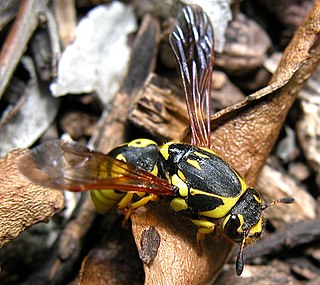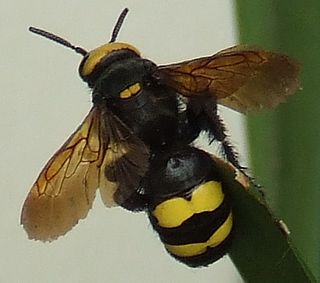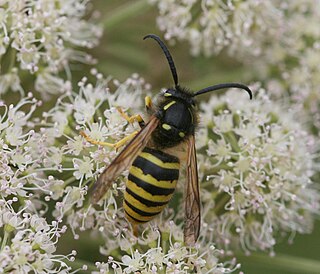
Hornets are the largest of the eusocial wasps, and are similar in appearance to yellowjackets, their close relatives. Some species can reach up to 5.5 cm (2.2 in) in length. They are distinguished from other vespine wasps by the relatively large top margin of the head. Worldwide, 22 species of Vespa are recognized. Most species only occur in the tropics of Asia, though the European hornet is widely distributed throughout Europe, Russia, North America, and north-eastern Asia. Wasps native to North America in the genus Dolichovespula are commonly referred to as hornets, but all of them are actually yellowjackets.

Yellowjacket or yellow jacket is the common name in North America for predatory social wasps of the genera Vespula and Dolichovespula. Members of these genera are known simply as "wasps" in other English-speaking countries. Most of these are black and yellow like the eastern yellowjacket and the aerial yellowjacket ; some are black and white like the bald-faced hornet. Some have an abdomen with a red background color instead of black. They can be identified by their distinctive markings, their occurrence only in colonies, and a characteristic, rapid, side-to-side flight pattern prior to landing. All females are capable of stinging. Yellowjackets are important predators of pest insects.

Sawflies are wasp-like insects that are in the suborder Symphyta within the order Hymenoptera, alongside ants, bees, and wasps. The common name comes from the saw-like appearance of the ovipositor, which the females use to cut into the plants where they lay their eggs. The name is associated especially with the Tenthredinoidea, by far the largest superfamily in the suborder, with about 7,000 known species; in the entire suborder, there are 8,000 described species in more than 800 genera. Symphyta is paraphyletic, consisting of several basal groups within the order Hymenoptera, each one rooted inside the previous group, ending with the Apocrita which are not sawflies.

Mud dauber is a name commonly applied to a number of wasps from either the family Sphecidae or Crabronidae which build their nests from mud; this excludes members of the family Vespidae, which are instead referred to as "potter wasps". Mud daubers are variable in appearance. Most are long, slender wasps about 1 inch (25 mm) in length. The name refers to the nests that are made by the female wasps, which consist of mud molded into place by the wasp's mandibles. Mud daubers are not normally aggressive, but can become belligerent when threatened. Stings are uncommon.

Pollen wasps, the Masarinae, are unusual wasps that are typically treated as a subfamily of Vespidae, but have in the past sometimes been recognized as a separate family, "Masaridae", which also included the subfamilies Euparagiinae and Gayellinae. It is a small subfamily, unique among wasps in feeding their larvae exclusively with pollen and nectar, in a fashion quite similar to many solitary bees. Most species are black or brown, marked with strikingly contrasting patterns of yellow, white, or red. They are most diverse and abundant in the desert regions of southern Africa, but also occur in the deserts of North and South America. Some species of Pseudomasaris in California, such as Pseudomasaris vespoides, bear a remarkable resemblance to yellow jackets, but can be recognized by their strongly clubbed antennae, a characteristic feature of the subfamily. Males have greatly elongated antennae, but still ending in a strong club.

The Bembicini, or sand wasps, are a large tribe of bembecid wasps, comprising 20 genera. Bembicines are predators on various groups of insects. The type of prey captured tends to be rather consistent within each genus, with flies (Diptera) being the most common type of prey taken. Nests are typically short, simple burrows, with a single enlarged chamber at the bottom which is stocked with freshly paralysed prey items for the developing wasp larva; the egg may sometimes be laid before the chamber is completely stocked. It is common for numerous females to excavate nests within a small area where the soil is suitable, creating large and sometimes very dense nesting aggregations, which tend to attract various species of parasitic flies and wasps, many of which are cleptoparasites; in some cases, the sand wasps prey on their own parasites (e.g.,), a surprisingly rare phenomenon in the animal kingdom. Although sand wasps are normally yellow and black, some are black and white with bright green eyes.

Polistes gallicus is a species of paper wasp found in various parts of Europe, excluding England, Denmark, and Scandinavia, from warmer climates to cooler regions north of the Alps. Nests of these social insects are created in these various conditions. The Polistes species use an oral secretion to construct their nests, which consist of a combination of saliva and chewed plant fibers. This structural mixture physically protects the nest from various harsh elements and from weathering over time.

A wasp is any insect of the narrow-waisted suborder Apocrita of the order Hymenoptera which is neither a bee nor an ant; this excludes the broad-waisted sawflies (Symphyta), which look somewhat like wasps, but are in a separate suborder. The wasps do not constitute a clade, a complete natural group with a single ancestor, as bees and ants are deeply nested within the wasps, having evolved from wasp ancestors. Wasps that are members of the clade Aculeata can sting their prey.

Conops quadrifasciatus, the yellow-banded conops, is a species of fly from the genus Conops in the family Conopidae.

Ptyelus grossus is an Auchenorrhynchan spittlebug in the family Aphrophoridae. Occurring from Southern Africa through to West Africa, the species is gregarious in its larval and nymph stages, feeding on a variety of plants, and producing protective shelters of acrid foam from their host plant's sap. Excreted in large quantities, the foam drips incessantly causing wet patches on the soil below.

The mammoth wasp is a species of wasp belonging to the family Scoliidae in the order Hymenoptera. It is a parasitoid on scarab beetles and is found in Europe and Asia and is the largest wasp found in Europe

The tree wasp is a species of eusocial wasp in the family Vespidae, found in the temperate regions of Eurasia, particularly in western Europe. Despite being called the tree wasp, it builds both aerial and underground paper nests, and can be found in rural and urban habitats. D. sylvestris is a medium-sized wasp that has yellow and black stripes and a black dot in the center of its clypeus. It is most common to see this wasp between May and September during its 3.5 month colony cycle.

Dolichovespula adulterina is a species of parasitic social wasp found in the Palearctic region. D. adulterina feeds on a variety of foods, including insects, spiders, arthropods, meat, molluscs, fruit, nectar, and larval secretions. D. adulterina was formerly considered to be synonymous with D. arctica from the Holarctic region, but more recent research indicates that D. arctica is a separate species.

Abispa splendida is a species of wasp in the Vespidae family.

Gorytes is a genus of sand wasps in the family Bembicidae. There are at least 70 described species in Gorytes.

Nysson spinosus, the large-spurred digger wasp, is a species of cleptoparasitic wasp of the family Bembicidae which is found in the Palearctic.
Gorytes willcoxi is a species of sand wasp in the family Bembicidae. It is found in North America.
Gorytes simillimus is a species of sand wasp in the family Bembicidae. It is found in North America.
Gorytes atricornis is a species of sand wasp in the family Bembicidae. It is found in North America.
Gorytes dorothyae is a species of sand wasp in the family Bembicidae. It is found in North America.
















